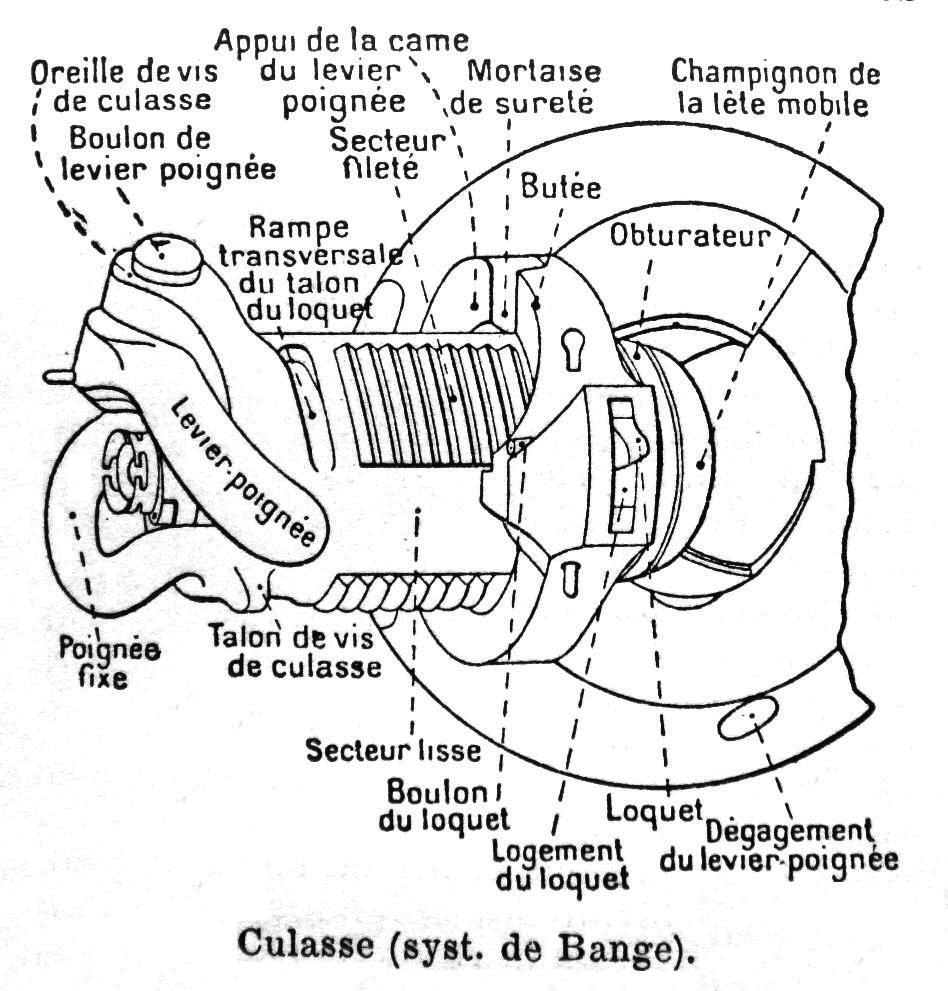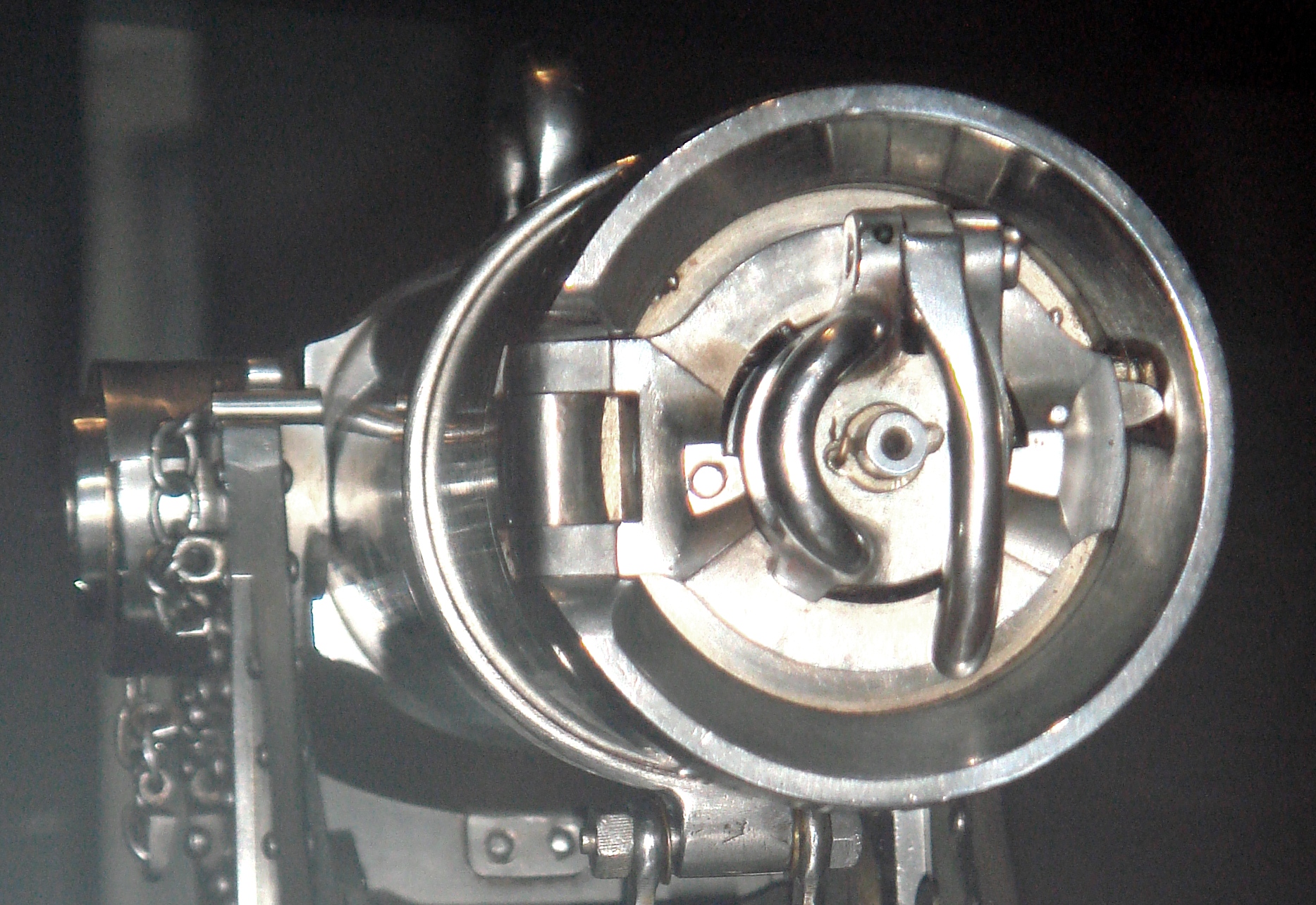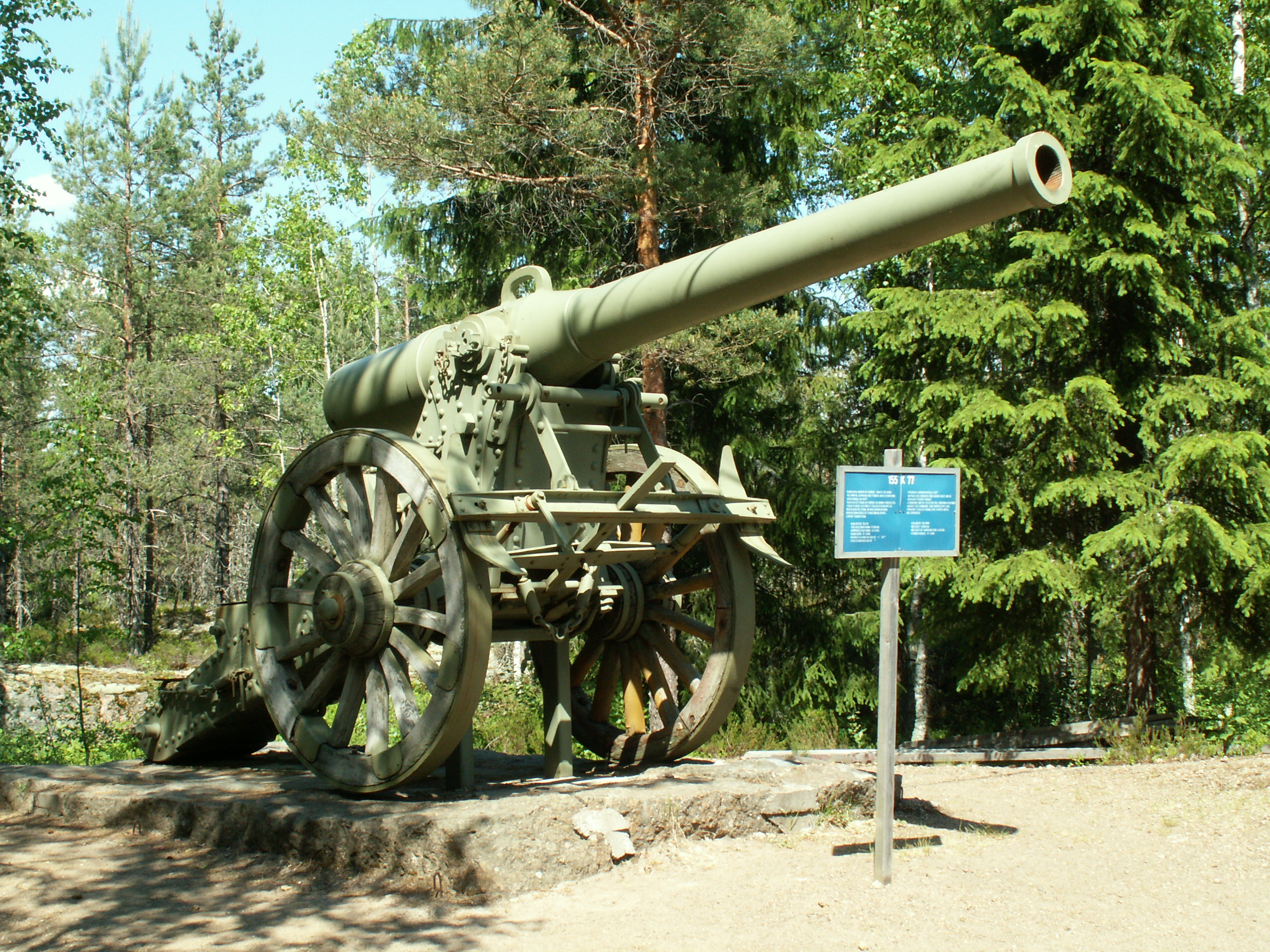Charles Ragon de Bange on:
[Wikipedia]
[Google]
[Amazon]
Charles Ragon de Bange (17 October 1833 – 9 July 1914) was a French




 Many attempts had been made at developing breech-loading cannons, but had only partial success sealing of the breech. When fired, hot gases and burning gunpowder could escape, losing power and potentially burning the operating crew. Rifles, with smaller loads and thus less stress, were able to use rubber in O-rings as on the
Many attempts had been made at developing breech-loading cannons, but had only partial success sealing of the breech. When fired, hot gases and burning gunpowder could escape, losing power and potentially burning the operating crew. Rifles, with smaller loads and thus less stress, were able to use rubber in O-rings as on the


 In 1873, de Bange became Director of the "Atelier-de-précision" in the Central Depot in
In 1873, de Bange became Director of the "Atelier-de-précision" in the Central Depot in
/ref> A street is named after him (''Rue du Colonel de Bange'') in the city of Versailles (city), Versailles.
File:Canonde155longmodèle1877NYTimes6June1915.jpg
File:Model 1877 155 mm gun Hameenlinna 1.JPG
File:Model 1877 155 mm gun Hameenlinna 2.JPG
File:French220mmTrenchMortar1915.jpg
File:Mortiersde220ToulGarrison.jpg
File:PostcardMortierde220CampdeChâlons.jpg
File:PostcardMortierde220OnWagon.jpg
Breech mechanismsData for all the guns in the De Bange system
{{DEFAULTSORT:Ragon de Bange, Charles French Army officers 19th-century French inventors Artillery of France École Polytechnique alumni 1833 births 1914 deaths
artillery
Artillery is a class of heavy military ranged weapons that launch munitions far beyond the range and power of infantry firearms. Early artillery development focused on the ability to breach defensive walls and fortifications during siege ...
officer and Polytechnician. He invented the first effective obturator system for breech-loading
A breechloader is a firearm in which the user loads the ammunition (cartridge or shell) via the rear (breech) end of its barrel, as opposed to a muzzleloader, which loads ammunition via the front ( muzzle).
Modern firearms are generally breech ...
artillery, which remains in use. He also designed a system of field guns of various calibers which served the French Army well into World War I
World War I (28 July 1914 11 November 1918), often abbreviated as WWI, was one of the deadliest global conflicts in history. Belligerents included much of Europe, the Russian Empire, the United States, and the Ottoman Empire, with fightin ...
: the ''Système de Bange''.
Career
De Bange breech obturator system




 Many attempts had been made at developing breech-loading cannons, but had only partial success sealing of the breech. When fired, hot gases and burning gunpowder could escape, losing power and potentially burning the operating crew. Rifles, with smaller loads and thus less stress, were able to use rubber in O-rings as on the
Many attempts had been made at developing breech-loading cannons, but had only partial success sealing of the breech. When fired, hot gases and burning gunpowder could escape, losing power and potentially burning the operating crew. Rifles, with smaller loads and thus less stress, were able to use rubber in O-rings as on the Chassepot rifle
The Chassepot (pronounced ''SHAS-poh''), officially known as ''Fusil modèle 1866'', was a bolt-action military breechloading rifle. It is famous for having been the arm of the French forces in the Franco-Prussian War of 1870–1871. It replace ...
. The same principle of breech sealing applied on cannons was not as easy to develop. Several materials were able to hold the pressure and heat of cannon fire, but did not expand like rubber, thereby failing to provide a tight seal. The most successful of those designs was the Broadwell ring The Broadwell ring is a small obturating ring used in 1860s and 1870s rifled breech loaders in Continental Europe to ensure obturation
In the field of firearms and airguns, obturation denotes necessary barrel blockage or fit by a deformed soft ...
invented by American engineer Lewis Wells Broadwell
Lewis may refer to:
Names
* Lewis (given name), including a list of people with the given name
* Lewis (surname), including a list of people with the surname
Music
* Lewis (musician), Canadian singer
* " Lewis (Mistreated)", a song by Radiohea ...
(who worked as a sales agent for the Gatling Gun
The Gatling gun is a rapid-firing multiple-barrel firearm invented in 1861 by Richard Jordan Gatling. It is an early machine gun and a forerunner of the modern electric motor-driven rotary cannon.
The Gatling gun's operation centered on a cyc ...
Company in Europe) in early 1860s and widely applied (without a license) by the Krupp
The Krupp family (see pronunciation), a prominent 400-year-old German dynasty from Essen, is notable for its production of steel, artillery, ammunition and other armaments. The family business, known as Friedrich Krupp AG (Friedrich Krup ...
company on their breech-loaders.
In 1872, de Bange designed the ''de Bange system'', a new type of obturating ring
{{Other uses, Obturator (disambiguation){{!Obturator
An obturating ring is a ring of relatively soft material designed to obturate under pressure to form a seal. Obturating rings are often found in artillery and other ballistics applications, and ...
for breech-loading artillery pieces. His system utilized the same general principle devised by Andrew Hotchkiss ca. 1855 for his rifled muzzle-loading projectiles, where two parts of the shell squeezed a soft (in that case lead) ring under the pressure of gunpowder fumes to obturate the barrel (see Rotation of ammunition
''Rotation of ammunition'' is a term used with reference to guns.
Projectiles intended for RML ( rifled muzzle-loading) guns were at first fitted with a number of gun-metal studs arranged around them in a spiral manner corresponding to the twi ...
), and used a breech block made of three parts; an interrupted screw locking mechanism at the rear, a doughnut-shaped grease-impregnated asbestos
Asbestos () is a naturally occurring fibrous silicate mineral. There are six types, all of which are composed of long and thin fibrous crystals, each fibre being composed of many microscopic "fibrils" that can be released into the atmosphere b ...
pad that sealed the breech, and a rounded movable "nose cone" at the front. When the gun fired, the nose was driven rearward, compressing the asbestos pad and squeezing it so it expanded outward to seal the breech. The French referred to the shape of the breech's nose as "mushroom like", as it resembled the cap of a mushroom
A mushroom or toadstool is the fleshy, spore-bearing fruiting body of a fungus, typically produced above ground, on soil, or on its food source. ''Toadstool'' generally denotes one poisonous to humans.
The standard for the name "mushroom" is t ...
.
The action was controlled by a handle, normally mounted vertically on the right side of the breech. When lifted, the handle operated a cam that forced the breech to rotate counter-clockwise, unlocking the interrupted thread. The entire breech was then pulled rearward with the same handle, sliding on a ring-shaped holder. The breech holder was hinged on one side, normally the left, so when the breech block was slid all the way to the rear it could be rotated out of the way for loading.
The de Bange system was widely adopted, including by the United States Navy
The United States Navy (USN) is the maritime service branch of the United States Armed Forces and one of the eight uniformed services of the United States. It is the largest and most powerful navy in the world, with the estimated tonnage ...
and the British Royal Navy
The Royal Navy (RN) is the United Kingdom's naval warfare force. Although warships were used by English and Scottish kings from the early medieval period, the first major maritime engagements were fought in the Hundred Years' War against F ...
. The technique developed by de Bange is still in use today.
The only major advance on the original de Bange system was the introduction of the stepped screw in the Welin breech block
The Welin breech block was a revolutionary stepped, interrupted thread design for locking artillery breeches, invented by Axel Welin in 1889 or 1890. Shortly after, Vickers acquired the British patents. Welin breech blocks provide obturation for ...
of 1889, which greatly increased the load-bearing surface of the breech, allowing them to be made shorter, simpler, more secure and faster to operate. Other block mechanisms are also used, but the de Bange obturator remains widespread even on these.
Manufacture of cannons


 In 1873, de Bange became Director of the "Atelier-de-précision" in the Central Depot in
In 1873, de Bange became Director of the "Atelier-de-précision" in the Central Depot in Paris
Paris () is the capital and most populous city of France, with an estimated population of 2,165,423 residents in 2019 in an area of more than 105 km² (41 sq mi), making it the 30th most densely populated city in the world in 2020. S ...
(Paris arsenal's precision workshop), in order to redesign French light and heavy artillery.
Between 1877 and 1881, de Bange developed several artillery pieces, such as the De Bange 90 mm cannon
The de Bange 90 mm cannon (Mle 1877) was a type of field artillery piece developed in France by Colonel Charles Ragon de Bange in 1877, and adopted by the French Army that same year. It superseded the earlier Reffye cannon (1870/73) and the L ...
(field artillery
Field artillery is a category of mobile artillery used to support armies in the field. These weapons are specialized for mobility, tactical proficiency, short range, long range, and extremely long range target engagement.
Until the early 20t ...
, 1877), the De Bange 80 mm cannon (mountain artillery
Mountain guns are artillery pieces designed for use in mountain warfare and areas where usual wheeled transport is not possible. They are generally capable of being taken apart to make smaller loads for transport by horses, humans, mules, tractor ...
, 1878), the De Bange 120 mm L cannon (siege artillery, 1878), De Bange 155 mm L cannon (siege artillery, 1877), De Bange 155 mm C howitzer (siege artillery, 1881), as well as mortars for siege warfare, such as the 1880 De Bange 220 mm mortar, 1885 De Bange 270 mm and coastal batteries such as the De Bange 240 mm and De Bange 270 mm. Several of these weapons were used during the colonial wars of the end of the 19th century, during the First World War
World War I (28 July 1914 11 November 1918), often abbreviated as WWI, was one of the deadliest global conflicts in history. Belligerents included much of Europe, the Russian Empire, the United States, and the Ottoman Empire, with fightin ...
and also sometimes during the Second World War
World War II or the Second World War, often abbreviated as WWII or WW2, was a world war that lasted from 1939 to 1945. It involved the vast majority of the world's countries—including all of the great powers—forming two opposin ...
. As with other cannons, the de Bange cannons had the disadvantage of being slow to fire, as they were affected by recoil
Recoil (often called knockback, kickback or simply kick) is the rearward thrust generated when a gun is being discharged. In technical terms, the recoil is a result of conservation of momentum, as according to Newton's third law the force requ ...
, and thus had to be re-aimed after every shot. This inconvenience would be solved with the appearance of the famous Canon de 75
Canon or Canons may refer to:
Arts and entertainment
* Canon (fiction), the conceptual material accepted as official in a fictional universe by its fan base
* Literary canon, an accepted body of works considered as high culture
** Western can ...
, that had a hydro-pneumatic recoil mechanism, which kept the gun's trail and wheels perfectly still during the firing sequence. However, there were two howitzers the Obusier de 120 mm C modèle 1890 and Obusier de 155 mm C modèle 1890 with de Bange breeches and recoil mechanisms designed by Captain Louis Henry Auguste Baquet. From 1882 to 1889, de Bange was Director of the Cail Manufacturing Corporation (''Société Anonyme des Anciens Etablissements Cail''), the forerunner of the ''Société française de constructions mécaniques'', where he worked on weapon design and trade, selling guns to such countries as Serbia
Serbia (, ; Serbian language, Serbian: , , ), officially the Republic of Serbia (Serbian language, Serbian: , , ), is a landlocked country in Southeast Europe, Southeastern and Central Europe, situated at the crossroads of the Pannonian Bas ...
.''Girding for Battle'' Ingrid A. Sandole-Staroste, Donald J. Stocker, Jonathan A. Grant, p.5/ref> A street is named after him (''Rue du Colonel de Bange'') in the city of Versailles (city), Versailles.
See also
*Cannons
A cannon is a large-caliber gun classified as a type of artillery, which usually launches a projectile using explosive chemical propellant. Gunpowder ("black powder") was the primary propellant before the invention of smokeless powder during ...
* Shells
*Canet guns
The Canet guns were a series of weapon systems developed by the French engineer Gustave Canet (1846–1908), who worked as an engineer from 1872 to 1881 for the London Ordnance Works, then for Forges et Chantiers de la Méditerranée, and from 1 ...
Gallery
De Bange 155mm cannon (1877)
De Bange 220mm mortar (1880)
References
External links
Breech mechanisms
{{DEFAULTSORT:Ragon de Bange, Charles French Army officers 19th-century French inventors Artillery of France École Polytechnique alumni 1833 births 1914 deaths